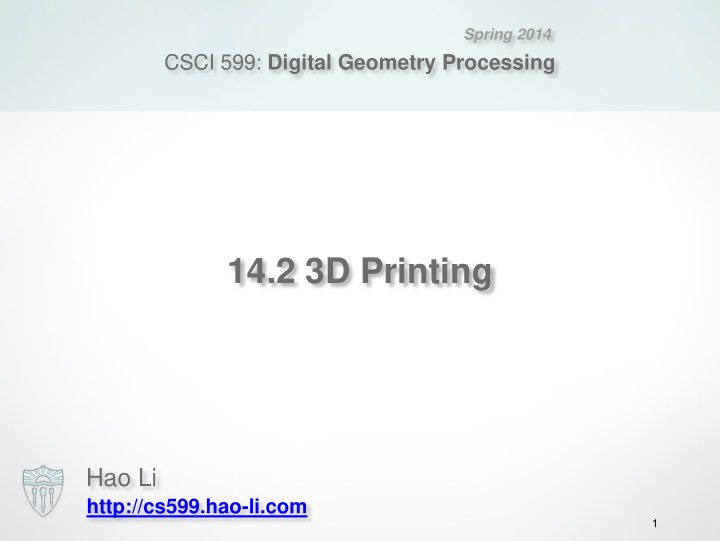



Spring 2014 CSCI 599: Digital Geometry Processing 14.2 3D Printing Hao Li http://cs599.hao-li.com 1
Why 3D Printers Become Popular? Prices are dropping Thousands of dollars to hundreds of dollars Smaller Sizes Industry oriented vs. Home oriented (desktop) Stories
Desktop 3D Printers
Where are we today?
Problem
ZEUS
New Communication Channel
Revolutionizing Online Shopping
Customization
Vision (Video)
3D Scanning in ZEUS
Process
Scanning Requirements Automatic: Take out all time-consuming tasks Can have guided simple user involvements Accurate and printable results Fast and always display progress: Good UI relieve user anxiety
Scanning – Basic Technique
Scanning - Basic Technique
Scanning - Details
Future Expansion
Meshing Find manifold surface from the scanned point cloud Requirements: Maintain as much recoverable details as possible (mostly on the point cloud) 15 minutes on an ARM/embedded processor Steps: Reduce the number of points Normal smoothing/estimation Surface reconstruction: Poisson Reconstruction
Mesh Repair Adapt raw mesh for printing Watertight globally consistent manifold Removes: Singularities, self intersections, degenerate elements, spurious geometry, topological noise
Slicing Cut solid into thin slices to be printed layer by layer Software: Cura, Slic3r, KISSlicer: gcode Both computational and practical Print through intersecting triangles in each plane at specified infill percentage Reduce strings/seams
3D Printing
Type of 3D Printing Technology
3DP – 3D Printing and Gluing 1. Apply Powder on the printing bed 2. Use inkjet head to apply glue on build area 3. Lower the printer bed 4. Repeat the process until done 5. Remove Unbounding powder 6. Dip to polymer for coating
3DP – 3D Printing and Gluing Pro: 1. Full Color Support 2. Medium detail of part 3. Non-toxic material Con: 1. Parts are rough & weak 2. Mess to clean up 3. Machine are big and expensive ($30K~$110K)
Polyjet – Jetted Photopolymer 1. Jet with polymer material 2. Use UV Light to cure polymer 3. Lower the printer bed 4. Repeat the process 5. Debonding support material Ref: http://www.3daddfab.com/technology/ , CustomPartNet
Polyjet – Jetted Photopolymer Pro: 1.Detail of surface finish 2.Translucent parts 3.Complex geometries Con: 1.Poor Strength 2.Toxic material 3.Limited Color 4.Expensive ($20K~$750K)
FDM (Fused deposition modeling) and FFF (Fused Filament Fabrication) 1.Heat plastic filament 2.Extrude liquid plastic on the bed 3.Lower the printer bed 4.Repeat the process until done 5.Remove Support Material
FDM (Fused deposition modeling) and FFF (Fused Filament Fabrication) Pro: 1. Open Source & Most popular 2. Inexpensive ($199~$199K) 3. Strong and Functional parts 4. Variety of material & Color 5. Non-toxic 6. Easy to clean up Con: 1. Poor Surface Finish 2. Limited detail 3. Layers bond are weaker
SLS (Selective Laser Sintering) and DMLS (Direct Metal Laser Sintering) 1. Heat plastic filament 2. Extrude liquid plastic on the bed 3. Lower the printer bed 4. Repeat the process until done 5. Remove Support Material
SLS – Selective Laser Sintering Pro: 1.Very Accurate 2.Durable and Functional 3.Affordable print cost Con: 1.Sandy Texture 2.Limited material 3.Machine are expensive $200K
DMLS – Direct Metal Laser Sintering Pro: 1.Direct Metal Printing 2.Durable and Functional Con: 1.Expensive
SLA 1.Heat plastic filament 2.Extrude liquid plastic on the bed 3.Lower the printer bed 4.Repeat the process until done 5.Remove Support Material
SLA Pro: 1.Second Most Popular 2.Low cost machine ( $2K) 3.High detail Con: 1.Poor Strength 2.Toxic material 3.Limited Color
LOM 1. Apply paper/film on the bed 2. Cut profile by moving knife or Laser 3. Apply Glue on the cutted area 4. Add one more layer on top 5. Repeat process
LOM Pro: 1.Can print in color 2.Cheap printing material(paper) Con: 1.Limited geometry 2.Poor finish 3.Waste a lot of paper 4.Expensive $50K http://www.youtube.com/watch?v=GVzRyKxD6Zc
http://cs599.hao-li.com Thanks!
Recommend
More recommend